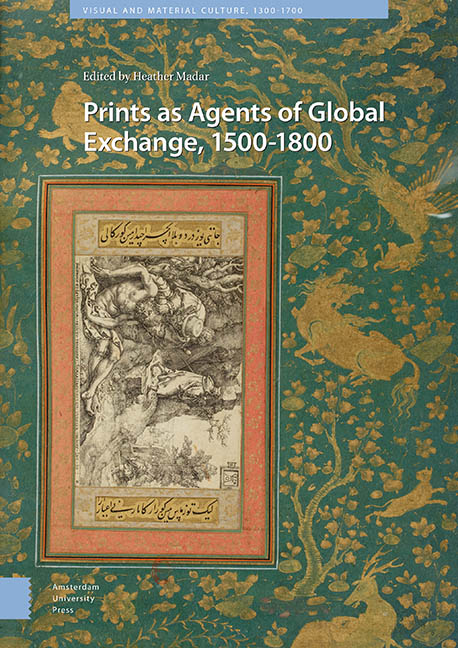Book contents
- Frontmatter
- Table of Contents
- List of illustrations
- Introduction
- 1 Concealing and Revealing the Female Body in European Prints and Mughal Paintings
- 2 The Sultan’s Face Looks East and West: European Prints and Ottoman Sultan Portraiture
- 3 From Europe to Persia and Back Again: Border-Crossing Prints and the Asymmetries of Early Modern Cultural Encounter
- 4 The Dissemination of Western European Prints Eastward: The Armenian Case
- 5 The Catholic Reformation and Japanese Hidden Christians: Books as Historical Ties
- 6 (Re)framing the Virgin of Guadalupe: The Concurrence of Early Modern Prints and Colonial Devotions in Creating the Virgin
- 7 Hidden Resemblances: Re-contextualized and Re-framed: Diego de Valadés’ Cross Cultural Exchange
- 8 The Practice of Art: Auxiliary Plastic Models and Prints in Italy, Spain, and Peru
- 9 Ink and Feathers: Prints, Printed Books, and Mexican Featherwork
- Index
7 - Hidden Resemblances: Re-contextualized and Re-framed: Diego de Valadés’ Cross Cultural Exchange
Published online by Cambridge University Press: 16 December 2021
- Frontmatter
- Table of Contents
- List of illustrations
- Introduction
- 1 Concealing and Revealing the Female Body in European Prints and Mughal Paintings
- 2 The Sultan’s Face Looks East and West: European Prints and Ottoman Sultan Portraiture
- 3 From Europe to Persia and Back Again: Border-Crossing Prints and the Asymmetries of Early Modern Cultural Encounter
- 4 The Dissemination of Western European Prints Eastward: The Armenian Case
- 5 The Catholic Reformation and Japanese Hidden Christians: Books as Historical Ties
- 6 (Re)framing the Virgin of Guadalupe: The Concurrence of Early Modern Prints and Colonial Devotions in Creating the Virgin
- 7 Hidden Resemblances: Re-contextualized and Re-framed: Diego de Valadés’ Cross Cultural Exchange
- 8 The Practice of Art: Auxiliary Plastic Models and Prints in Italy, Spain, and Peru
- 9 Ink and Feathers: Prints, Printed Books, and Mexican Featherwork
- Index
Summary
in memoriam Elenae Estrada de Gerlero, carae magistrae quae vitam arti Novae Hispaniae dicavit
“l’istesso sugetto ma non la medesima inventione” Giacomo Lauro, Archivo di Stato di Roma Senatore Tribunale Criminale, 1224, fol. 147v.
Abstract
The Rhetorica Christiana by Franciscan missionary and humanist Diego Valadés (Perugia, 1579) is notable for its engravings and the method used, ars memorativa, to convert Indigenous people to Catholicism. This collaboration centers on two engravings. It contends that their style reflects the process of imitatio: the practice of copying iconographic elements (delineare) from models to reconfigure them in a new composition (inventio), and sheds light on the Humanist learning methods Valadés was trained under. While portraying Indigenous culture adapted to Catholic education to promote Franciscan methods of conversion in New Spain, he developed his own style (maniera), concurrent with the concepts he wanted to express, the restitution of missionary values belonging to the primitive church and the applicability of aspects of Indigenous knowledge (timekeeping).
Keywords: Imitatio, style, primitive Church, calendar wheels, missionaries, New Spain
This study of the Rhetorica Christiana (Perugia: Petruzzi, 1579) by Diego Valadés shares with other kinds of research a concern for its conjunction of text and image related to visual modes of learning. In common with other studies focused on the study and practice of rhetoric it considers the relationship with Cinquecento humanist ars memorativa, and Valadés’ exaltation of Franciscan missionary efforts in the conversion of the New World in order to frame the Rhetorica within the political and theological program conceived by the papal seat in Rome during the times of Gregory XIII (1572-1581). Like earlier research, this chapter also pays attention to Franciscan missionary relations to encyclopedic-Lullism, developed by humanist thinkers and considers the dependence on iconographic-emblematic discourse of political-religious circles surrounding Benito Arias Montano and the Antwerp printer publisher Christophe Plantin, while it records the motifs and iconographic sources of the Rhetorica, as well as the formal variety and style of its twenty seven copper engravings. In mainstream research less interest has been placed on the creative process of Valadés, the sequence of actions, recreation (imitatio) and conception (invention) behind his Rhetorica, perhaps given the lack of sources and information surrounding its making.
- Type
- Chapter
- Information
- Prints as Agents of Global Exchange1500-1800, pp. 215 - 260Publisher: Amsterdam University PressPrint publication year: 2021



